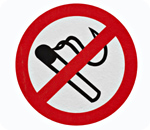Use natural remedies to quit smoking
(NaturalNews) Smoking is more than just a bad habit; it's an addiction. Governments try to fight smoking by making policies to raise taxes and the price of cigarettes so fewer people can afford them. This might work for some, but for people who are truly addicted, real help to break the addiction is needed. Herbs, natural chemicals and support groups can help people quit smoking naturally.
Rhodiola extract in the mornings can increase dopamine receptors. Dopamine is a hormone associated with mood. Too little dopamine can lead to anxiety and depression. Increasing dopamine receptors and uptake can make people feel happier, more energetic and less like smoking a cigarette.
People often feel nauseated when they are in withdrawal from nicotine. Ginger root may reduce nausea. Lobelia can be toxic so caution is needed when using.
Oats can also directly help smokers quit. An extract derived from green oats can ease withdrawal symptoms and help to decrease cigarette cravings.
The main benefits of herbal cigarettes are that they are not additive. These cigarettes contain zero nicotine. They are made with herbs such as mint, cinnamon, clover, cornsilk, licorice or lemongrass. They also have some carcinogens so they should only be used as a short-term aide to break the nicotine habit and not long-term.
Sources for this article include:
http://www.helpguide.org/mental/quit_smoking_cessation.htm
http://www.stopsmoking.net/natural-quit.html
http://www.ehow.com
http://www.health.com/health/gallery/0,,20307113,00.html
http://naturalhealingtipsblog.blogspot.com
About the author:
Sarka-Jonae Miller is a health writer and novelist. She was certified as a personal fitness trainer through the National Academy of Sports Medicine and the Aerobics and Fitness Association of America. She also worked as a massage therapist, group exercise instructor and assistant martial arts instructor.
Get more health and wellness tips on Sarka's blog, www.naturalhealingtipsblog.com
Connect with Sarka on Facebook http://www.facebook.com/pages/Sarka-Jonae-Miller/168691386526181
or on Twitter @sarkajonae
Learn more: http://www.naturalnews.com/036620_natural_remedies_quit_smoking_herbal.html#ixzz22DJxiuFx
Herbal remedies for smoking cessation
There are a variety of herbs and supplements that can help people stop smoking. Some herbs to consider include lobelia for cigarette cravings, ginger root for nausea, St. John's Wort for depression, passion flower for irritability, and rhodiola for energy.Rhodiola extract in the mornings can increase dopamine receptors. Dopamine is a hormone associated with mood. Too little dopamine can lead to anxiety and depression. Increasing dopamine receptors and uptake can make people feel happier, more energetic and less like smoking a cigarette.
People often feel nauseated when they are in withdrawal from nicotine. Ginger root may reduce nausea. Lobelia can be toxic so caution is needed when using.
Oats
Oats are a heart healthy food that is high in fiber, omega-3 fatty acids, potassium, and folate. Eating oats can help lower levels of bad cholesterol and keep arteries clear, which helps to lower risk of heart disease. They also contain chemicals called avenathramides that can reduce stress, strengthen the nervous system, fight free radials, and combat high blood pressure. All of these benefits can be crucial for smokers who are at a higher risk for heart disease.Oats can also directly help smokers quit. An extract derived from green oats can ease withdrawal symptoms and help to decrease cigarette cravings.
Herbal cigarettes
Herbal cigarettes can replace regular cigarettes and help break the addiction. Smokers become used to reaching for a cigarette in certain situations and at specific times during the day. Sometimes a cigarette is about familiarity or comfort more than nicotine. Herbal cigarettes contain fewer chemicals and carcinogens in regular cigarettes. People can substitute herbal cigarettes to meet their psychological need for a smoke without compromising their health.The main benefits of herbal cigarettes are that they are not additive. These cigarettes contain zero nicotine. They are made with herbs such as mint, cinnamon, clover, cornsilk, licorice or lemongrass. They also have some carcinogens so they should only be used as a short-term aide to break the nicotine habit and not long-term.
Free support
The American Lung Association has a free online program called Freedom from Smoking Online that offers assistance to people looking to quit smoking. People can also call 1-800-QUIT-NOW or go to Nicotine Anonymous meetings for support and information.Sources for this article include:
http://www.helpguide.org/mental/quit_smoking_cessation.htm
http://www.stopsmoking.net/natural-quit.html
http://www.ehow.com
http://www.health.com/health/gallery/0,,20307113,00.html
http://naturalhealingtipsblog.blogspot.com
About the author:
Sarka-Jonae Miller is a health writer and novelist. She was certified as a personal fitness trainer through the National Academy of Sports Medicine and the Aerobics and Fitness Association of America. She also worked as a massage therapist, group exercise instructor and assistant martial arts instructor.
Get more health and wellness tips on Sarka's blog, www.naturalhealingtipsblog.com
Connect with Sarka on Facebook http://www.facebook.com/pages/Sarka-Jonae-Miller/168691386526181
or on Twitter @sarkajonae
Learn more: http://www.naturalnews.com/036620_natural_remedies_quit_smoking_herbal.html#ixzz22DJxiuFx


